|
|
|
Shape
Changes On Stringed Instruments
A violist with chronic back trouble or left hand tendinitis already knows
that playing a huge, traditionally shaped instrument is the wrong way
to meet sonority demands. But suppose a violin maker starts with an undersized
viola that is easy to play but is also characteristically weak sounding:
Then stretches it in places that don't interfere with the mechanics of
playing:
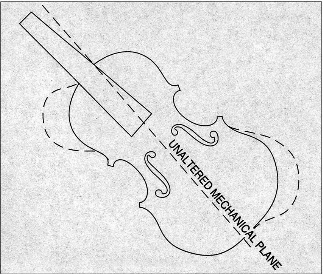
Certainly there is plenty of room for this kind of expansion. And the
only thing sacrificed is visual symmetry. Does the shape change do anything
to the sound? No. Researchers have been taking pictures of violin sound
waves since the advent of specialized photographic techniques that were
introduced in the middle of the twentieth century. Because the bass-bar
is glued off-center to one side of the belly, and the sound post is nudged--again
off-center--against the back, sound waves emitted by bowed stringed instruments
(especially their bellies) aren't symmetrical even when the instruments
themselves are. They look something like this:
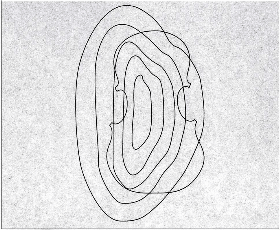
In fact, almost all stringed instruments, bowed or not, are asymmetrical
in their acoustics, and for a very good reason. The idea is to have different
sized vibrating surfaces which "specialize" in certain ranges of pitch,
like a woofer and a tweeter in a speaker system. Stringed instruments
that don't have this diversity of vibrating surface tend to sound strong
in a limited, narrow range and weak everywhere else. If anything, the
violin and the violas described on this web site, especially the Pellegrina,
are acoustically enhanced by their break from visual tradition. This is
particularly true when the deviation in shape results in added overall
corpus size. Again, the shape changes on the Pellegrina give it a greatly
expanded acoustic chamber. Compare these statistics:
|
Typical Strad Model
Viola |
4 |
Pellegrina |
| belly length |
16 inches |
4 |
20 inches |
| upper bouts |
7 3/4 inches |
4 |
10 5/16 inches |
| waist |
5 1/4 inches |
4 |
5 5/8 inches |
| lower bouts |
9 5/8 inches |
4 |
12 3/16 inches |
This results in more vibrating surface area. And the bigger the surface area the bigger the sound, especially in the lower register. Well-made
small violas can sound tolerably good on their upper strings. It is the C and G strings that are usually inadequate. Enlarging the acoustic chamber
of the Pellegrina is an important part of bringing back strength of sound in the lower register without resorting to strings that are uncomfortably
long for the player. And this additional acoustic chamber on the Pellegrina is what
makes it unique. But there are other important changes that are included in all of the instruments described here.
String Angles
In the nineteenth century players' demands for more volume and intensity of sound led to changes in stringed instrument construction. In part, these
demands were met by raising the instruments' necks, which in turn changed the angle at which the strings passed over the top of the bridge:

Over the decades, this alteration has worked well for both violin and cello, but during the development of the Pellegrina, it became clear that
the optimum angle for the A string of a small viola is different from its C string. Special construction practices are called for. On the
Pellegrina and Riviola an important structural innovation corrects
this disparity by moving the tailpiece slightly out of alignment with both the fingerboard and bridge:
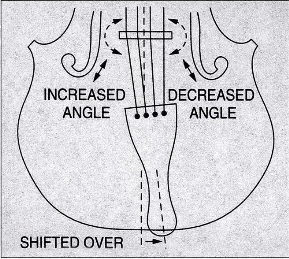
At the same time, the necks of these instruments have been raised more than is usually done. The result on the Pellegrina, for example, is 5 degrees
more angle on the C string than on the A. In the realm of viola acoustics, that's a lot! It's more than enough to
compensate for any sonority loss resulting from a shorter, more manageable string length. And the same
principle works on the Riviola instruments--both four and six string.
Fingerboard Banking
Banking the fingerboards has turned out to be one of the single most important design characteristics in every single instrument described on
this site. In order to appreciate what this innovation does, it's helpful to understand "supination". Pretend you are reaching for a round door knob
with your left hand. You are going to open the door by turning the knob counterclockwise just as far as your shoulder, arm and hand will allow
you to twist. The
position that results from this twisting motion is called supination and any violinist or
violist will immediately recognize a "supined" left arm as an arm in
playing
position.
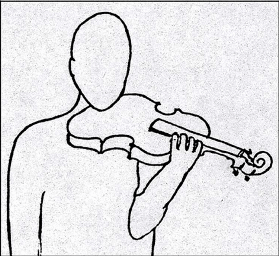
Violinists and violists hold their left arms in a supined position for
hours on end, despite the knowledge that this is, orthopedically, very unhealthy.
Banking the fingerboard significantly lessens the amount of supination required of the
player's left arm.
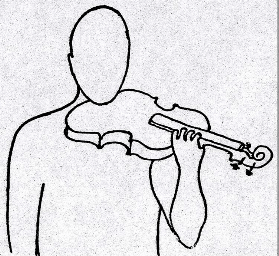
Suddenly the stretch to the viola C string in first position is as
comfortable as playing the D string in third position. And the relief to the violinist is
comparable. This design change alone has now resulted in rescuing the careers of several
professional players whose musical working lives were suddenly--and prematurely--over.
Of course, were one to try banking the fingerboard on a traditional, symmetrical
instrument, the results would be disastrous. As soon as the player tried to draw the bow
across a viola A string or, comparably, a violin E string, the frog would crash into the
belly of the instrument:

But a careful examination of the photos under the headings Pellegrina, Riviola or
Maximilian Violin on this web site reveals what asymmetry can do. On some of these instruments, the necks, bridges and tailpieces have
been shifted out of center and over to the treble side. On the rest, especially the Pellegrina and Maximilian, the bow clearance has been acheived by actually changing the rib heights; raising them on the base side and lowering them on the treble side. This allows the fingerboard to be banked enough to take considerable stress off the
player's left arm. As an additional aid, the lower right corners of these instruments have been removed, and together these two innovations make for
much more comfortable--and healthy--playing with plenty of bow clearance.
Bridge Cutting
Another important change on many of the instruments described here has to do with the way
their bridges are made. The job of the bridge is to support the strings and to
transmit
vibrations to the bass-bar and sound post. All that happens right near the arrows on the
figure below:
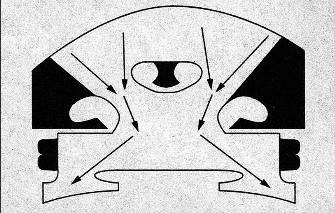
The rest of the wood on the bridge--about 25% of it--is non-structural and actually has a muting effect. On a violin, much of this extra wood is
important because, although it dampens the sound slightly, it also colors it, adding richness and depth. Violins with all non-structural wood
removed from their bridges tend to sound harsh and grating. But strategic removal of this extra bridge wood, especially on small violas, has a
helpful effect, that of enlivening the sound and improving the responsiveness:
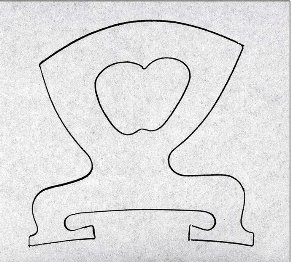
Weight...and Conscience
String players routinely
glide up and down their instruments' black fingerboards, turn black pegs
and completely take for granted the other black items on their instruments
such as the button, saddle and nut. Yet, one wonders how many of them know
that the black trees used to make these accessories--ebony trees--are in
trouble. If these majestic, slow-growing hardwoods were native to the
United States they would have been put on the endangered species list
decades ago. But they grow in such third world
countries as Ceylon, India and the African Island of Madagascar. And these nations, with limited budgets and overworked (sometimes corrupt)
governments have no resources or time to control the devastation of their ebony forests. The slaughter, largely to satisfy the international demands
of violin makers, continues unabated.
The saddest part is that there are so many excellent alternatives available. The few violin makers who are pursuing the numerous options are
working with everything from high-tech materials like carbon fiber and graphite to the simple and lightweight phenolic resin veneers used on the
instruments described here. These durable, practical phenolic fingerboards have resulted in an overall 10% weight loss on every instrument described
on this site. And having to hold up 10% less weight for the duration of--say--a Wagner opera, makes a huge difference!
In fact, putting these instruments "on a diet" is a high ergonomic
priority. They are made with almost no ebony at all.
Small Setups
Because violas are, roughly, 14% larger than violins, builders, for centuries, have made the setups on these instruments comparably bigger.
For players with large hands this has been fine. But for the vast majority of violists whose hands are just about normal in size, these setups are
unwieldy. For the violas described on this site, another approach is taken. Should a player have big hands and request a little bit more
mechanical maneuvering room, that wish is, of course, honored. But for everyone else, the setups are smaller with narrower string spacing to make
double stops easier, thinner necks that feel a bit less like baseball bats and bridges designed to bring the strings closer to the fingerboard and
make less work for busy "flying" fingers. And for violinists, the setup on the Maximilian Violin is also smaller, requiring almost no effort for stressed left hands.
Extra Sound holes On
The Pellegrina
An examination of the photos under the heading Pellegrina on
this web site will reveal two extra sound holes, one in the extended upper left bout and the other in the comparably elongated lower right bout. The
reason for them is simple. Experiments have shown that the Pellegrina, with its expansive vibrating surface area, simply performs better with extra
"slits" for the sound to escape from. The sound is more immediate and a
little bit clearer.
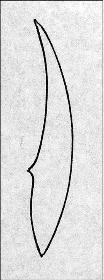
|

